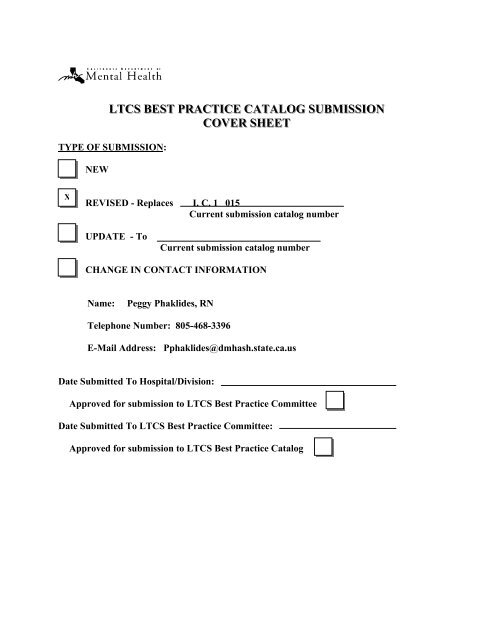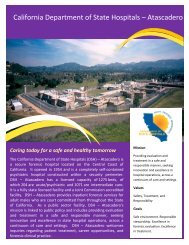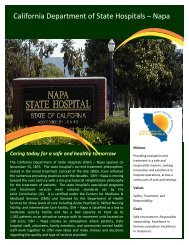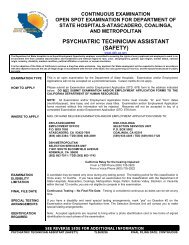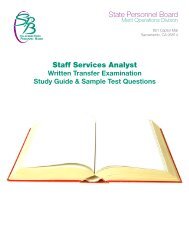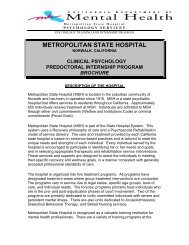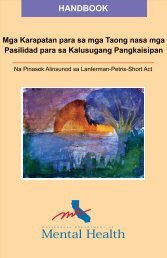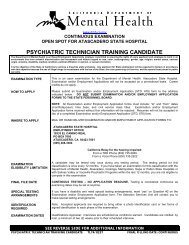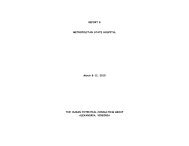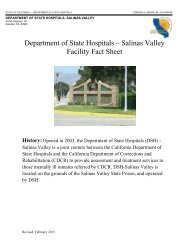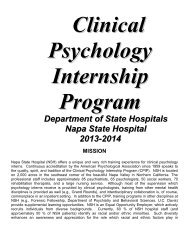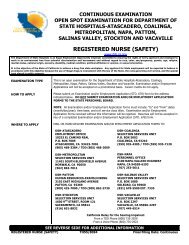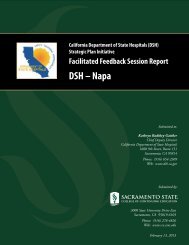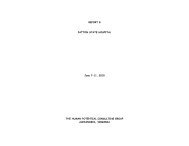Restraint Flow Chart - (R/S Documentation Sheet) - Dept of State ...
Restraint Flow Chart - (R/S Documentation Sheet) - Dept of State ...
Restraint Flow Chart - (R/S Documentation Sheet) - Dept of State ...
You also want an ePaper? Increase the reach of your titles
YUMPU automatically turns print PDFs into web optimized ePapers that Google loves.
LTCS BEST PRACTIICE CATALOG SUBMIISSIION<br />
COVER SHEET<br />
TYPE OF SUBMISSION:<br />
NEW<br />
X<br />
REVISED - Replaces I. C. 1 015<br />
Current submission catalog number<br />
UPDATE - To<br />
Current submission catalog number<br />
CHANGE IN CONTACT INFORMATION<br />
Name:<br />
Peggy Phaklides, RN<br />
Telephone Number: 805-468-3396<br />
E-Mail Address: Pphaklides@dmhash.state.ca.us<br />
Date Submitted To Hospital/Division:<br />
Approved for submission to LTCS Best Practice Committee<br />
Date Submitted To LTCS Best Practice Committee:<br />
Approved for submission to LTCS Best Practice Catalog
LTCS BEST PRACTIICE CATALOG SUBMIISSIION<br />
Project Title: <strong>Restraint</strong> <strong>Flow</strong> <strong>Chart</strong> – (R / S <strong>Documentation</strong> <strong>Sheet</strong>) REVISED<br />
Function Category:<br />
X<br />
PATIENT-FOCUSED ORGANIZATION STRUCTURES<br />
Sub-category(s): Care <strong>of</strong> Patient<br />
Heading: Behavior Management<br />
Contact Person: Peggy Phaklides, RN Telephone Number: 805-468-3396<br />
E-Mail Address: Pphaklides@dmhash.state.ca.us<br />
Hospital:<br />
Atascadero <strong>State</strong> Hospital<br />
The following items are available regarding this Best Practice:<br />
Sample <strong>Flow</strong> <strong>Sheet</strong><br />
Photographs Video Tape Drawings Manual<br />
1. SELECTION OF PROJECT/PROCESS AREA (Describe how and why your team selected this<br />
project/process area for improvement.):<br />
The <strong>State</strong> and Federal laws and regulations, as well as the JCAHO standards, governing the<br />
application and use <strong>of</strong> any form <strong>of</strong> restraint or seclusion have inherently stringent guidelines.<br />
<strong>Documentation</strong> surrounding the use <strong>of</strong> restraint or seclusion must then contain all the<br />
required elements to justify its use and ensure that the patient’s rights have not been violated.<br />
The new revised version <strong>of</strong> this form includes 2 changes that further improve the form’s<br />
usefulness<br />
1. A title change on the form including check boxes so the form can either be used or<br />
<strong>Restraint</strong> and Seclusion OR be used to chart 15 minute observations on patients who<br />
need very similar documentation but are not in restraint or seclusion.<br />
I. C. 1. 015
2. <strong>Documentation</strong> elements required from the new JCAHO Pain Management assessment<br />
standards.<br />
2. UNDERSTANDING EXISTING CONDITION WHICH NEEDS IMPROVEMENT<br />
(Describe the relationship <strong>of</strong> your project to your goals for improvement, and describe current process<br />
performance.):<br />
The Level <strong>of</strong> Care staff when documenting the patient’s physical and mental condition, level<br />
<strong>of</strong> restraint used, nursing care given, fluid intake/output, documentation <strong>of</strong> the patient’s<br />
behaviors every fifteen minutes, and summary documentation every two hours required the<br />
use <strong>of</strong> several forms located in different sections <strong>of</strong> the medical record. Due to the logistics<br />
<strong>of</strong> forms/documents within the chart, omission or incomplete documentation is possible. The<br />
absence <strong>of</strong> any <strong>of</strong> this vital information places the staff and hospital in a vulnerable position.<br />
3. ANALYSIS (Describe how the problem was analyzed.):<br />
Ongoing chart audits by numerous departments, as well as the Patients’ Rights Advocate<br />
revealed less than perfect documentation surrounding the use <strong>of</strong> restraint or seclusion. A<br />
consolidated method to document the nursing care provided and the patient’s progress was<br />
deemed necessary to obtain a complete, current and ongoing picture <strong>of</strong> the patient’s status.<br />
4. IMPLEMENTATION (Describe your implementation <strong>of</strong> the solution.):<br />
A team <strong>of</strong> staff met to review all required elements R & S documentation, establish weak<br />
points and redundancies <strong>of</strong> chartings, and develop at tool, the “<strong>Restraint</strong> <strong>Flow</strong> <strong>Sheet</strong>”, to<br />
solve the problem. The form is printed on 1-side, on an easily recognizable colored card<br />
stock page and is filed chronologically in the ID notes <strong>of</strong> the patient’s chart.<br />
5. RESULTS (Demonstrate that an improvement has occurred as a result <strong>of</strong> the project/process area<br />
implementation.):<br />
The tool provides a 24hour tracking sheet which prompts the nursing staff to review and<br />
address the essential elements required in the documentation <strong>of</strong> a patient’s status while in<br />
restraint or seclusion. Vital elements include 1) nursing care provided, e.g., ROM, I & O,<br />
vital signs, skin condition assessments , environmental conditions, etc.; 2) review <strong>of</strong> alerts for<br />
risk factors in the use <strong>of</strong> restraint or seclusion; 3) triggers for referral for consults if the<br />
patient is in R&/or S for greater than 72-144-216 hours; 4) denial <strong>of</strong> rights considerations;<br />
and 5) every 15 minutes observations <strong>of</strong> the patient’s behaviors, and now, Pain<br />
Management Assessment. With the consolidation <strong>of</strong> numerous forms into one tool, in one<br />
location, the level <strong>of</strong> care staff are able to focus the written documentation in the<br />
I. C. 1. 015
interdisciplinary notes to delineate the patient factors, (mental and behavioral) which justify<br />
the continued use <strong>of</strong> R&S.<br />
6. LEARNING (Describe what the team learned and how they used those lessons to continuously<br />
improve the success <strong>of</strong> this Best Practice.):<br />
The team found that incorporation <strong>of</strong> numerous requirements from several different sources,<br />
into an existing and already complicated system is fraught with numerous problems. Input<br />
solicited from all levels <strong>of</strong> the organization can help with buy-in and facilitate the process to<br />
a desirable outcome. The team also discovered that once the change and acceptance to the<br />
new documentation system was completed, the level <strong>of</strong> care staff found more time was<br />
available for direct patient care, less time was spent on the documentation, and compliance<br />
with the regulatory requirements was improved.<br />
I. C. 1. 015


